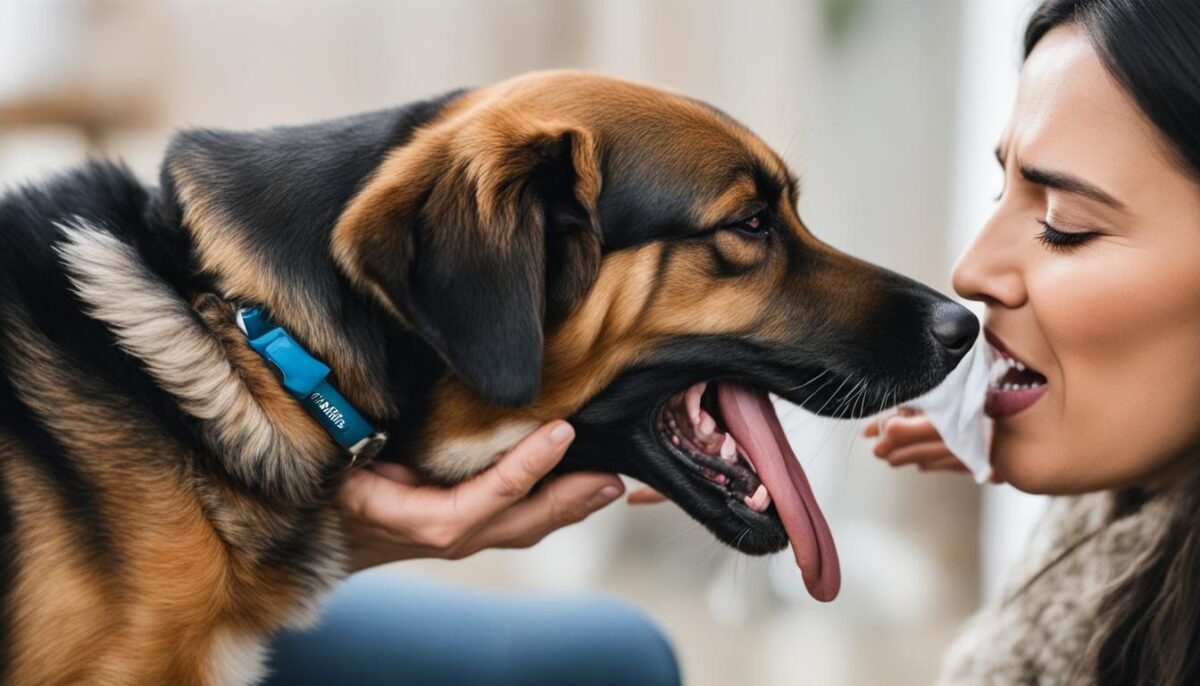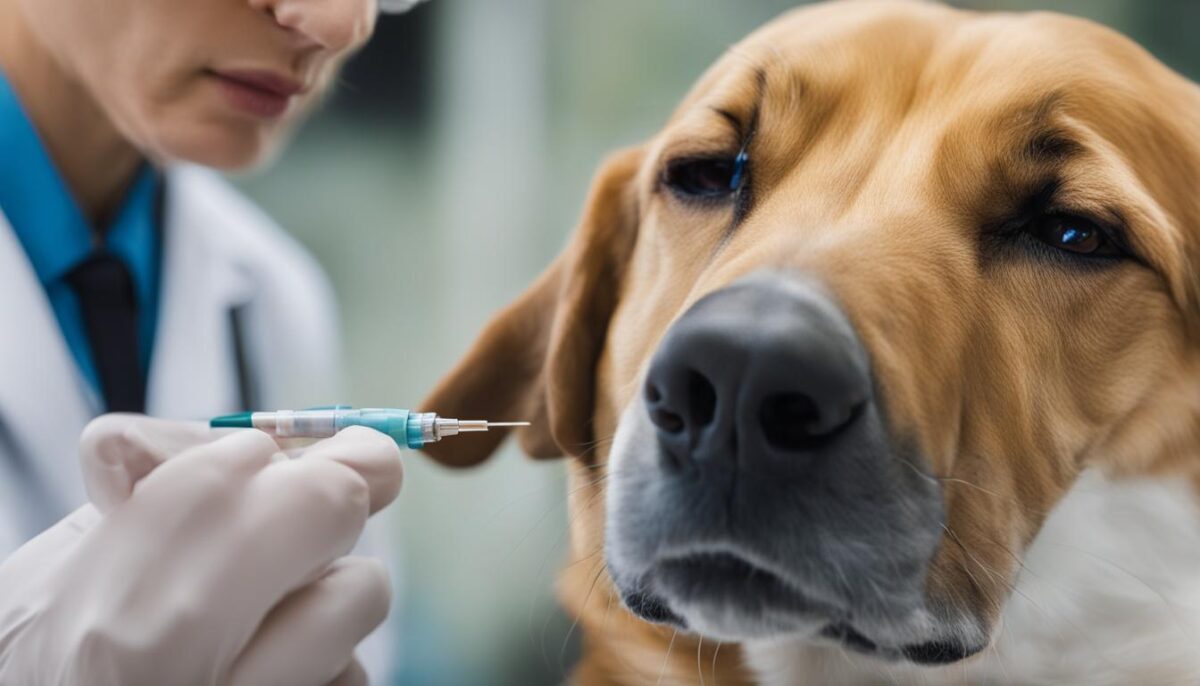Hey there! Have you ever wondered if your furry friend can catch the flu just like you? Well, they sure can. It’s called canine influenza, and it’s a sickness that dogs can get from each other.
The symptoms might look a little like when you feel icky with a cough or runny nose. Yep, dogs can have those too! There’s a couple of flu types that dogs can get, and they’re named H3N8 and H3N2. Just so you know, these flus are just for dogs – you can’t catch them from your pup.
Sometimes, your best buddy might seem just fine but could still have this dog flu. So, it’s pretty important to keep an eye on them and make sure they’re feeling okay.
By learning about dog flu symptoms and how to take care of pet health, you can help your dog stay happy and healthy. Plus, you’ll be super at keeping the flu in dogs from spreading to other pooches.
Key Takeaways
- Dogs can get something called canine influenza, which is like the flu for them.
- There are two main kinds of dog flu: H3N8 and H3N2, but they can’t make people sick.
- Watch for dog flu symptoms like coughing, stuffy noses, and feeling tired.
- Not all dogs that have the flu will look sick, so it’s good to know what to look for.
- Keeping dogs well and checking for the flu makes sure they and their friends stay healthy.
- You can’t get the flu from your dog, so you don’t need to worry about that.
Understanding Canine Influenza
Dogs can get sick with something called canine influenza, or dog flu. It’s a sickness that makes dogs cough and feel not so perky. It’s caused by special germs called Type A influenza viruses that only make dogs, not humans, sick. Just like humans, dogs can catch the flu from other dogs.
When we talk about these germs, we hear about things like the dog flu H3N8 virus and H3N2 virus in dogs. These names might sound a bit confusing but they’re just a way to tell the different flu germs apart. Think of them as different types of candy – they’re both sweets, but they taste a bit different.
What Is Canine Influenza?
Canine influenza is just a science-y name for dog flu. If your dog is coughing, has a runny nose, or doesn’t want to eat, it could be dog flu. It’s important to know that dogs can’t give this flu to their human friends – it’s a dog-only problem.
The Science Behind Dog Flu Viruses (H3N8 and H3N2)
There are two main types of dog flu germs: the H3N8 virus and the H3N2 virus. They got these names because of the way they look under a microscope. These germs can jump from dog to dog and even to cats, but not to humans.
Origins of Canine Influenza Strains
The dog flu didn’t start out in dogs. The virus that causes H3N8 dog flu first showed up in horses years ago, but in 2004, it started making dogs sick in the United States. The H3N2 canine influenza made its first appearance in dogs much later, in South Korea, in 2007, and then it traveled across the world, even reaching many places in the U.S.
| Flu Type | Origin Animal | First Seen in Dogs | Places Found |
|---|---|---|---|
| H3N8 | Horses | 2004 in the U.S. | United States |
| H3N2 | Unknown | 2007 in South Korea | South Korea, China, Thailand, the United States, and more |
Can Dogs Get the Flu and Transmit It to Humans?
Just like people, dogs can catch the flu. But guess what? Even though dogs can get sick from the flu, there’s no evidence to show that dog flu can jump to humans. This means the risk of humans catching the flu from their furry friends is really low. That’s good news for us! Scientists say dogs with the flu can’t start a flu pandemic in people. So, even though we love our pets a lot, we don’t have to worry about catching the flu from them.
Health experts keep an eye on dogs that look sick to make sure they don’t bring the flu into the U.S. Sick dogs might not be allowed to come in, or they might need to check in with a vet first. This helps stop the flu from spreading to other dogs and keeps everyone safe.
- Dog flu is for dogs, not for people.
- Scientists haven’t found dog flu in humans.
- Sick dogs can be stopped at the border to protect other dogs.
Always remember to take care of your pets. If your dog gets the flu, it’s important to keep them away from other dogs. This will help stop the spread of canine influenza.
Recognizing Symptoms of The Dog Flu
When your furry friend is under the weather, it can be worrying. Knowing the dog flu signs and canine influenza symptoms is crucial. If you see your pet not being as playful as usual or not eating well, they might have a pet respiratory illness.
Identifying Common Signs of Canine Influenza
Your pet might cough, have a runny nose, or seem warmer than usual – these are signs of the flu in dogs. Eyes that are runny or a little squinty, and a change in how much your dog eats, are also clues. These canine illness behaviors tell us our pets are not feeling great and need our help.
When to Consult a Veterinarian for Your Dog’s Symptoms
If your doggie pal shows any flu-like actions such as coughing or being super tired, talking to a vet is very important. A dog flu veterinarian consultation can help a lot. A vet can tell you the best pet health advice and whether your dog needs special medicine or care.
Understanding the Range of Symptoms from Mild to Severe
Just like us, our canine pals can feel a little sick or a lot sick. Some doggies with the flu might just need some rest, while some may feel very bad and need more help. It can be really serious, so knowing about canine flu severity, dog influenza complications, and when to get pet health assessments is super important to keep your dog safe and healthy.
Preventing and Treating Canine Influenza
Keeping your furry friend safe from the dog flu involves both prevention and care. Let’s explore how you can guard against this illness and help your pet feel better if they get sick.
Available Vaccinations for Dogs
Vaccines are like health shields for pets. They help protect your dog from getting sick with the flu. There are special health shots for pets for both H3N8 and H3N2 flu viruses. A quick chat with your vet can tell you if these canine influenza vaccines are right for your pup.
Treatment Options for Infected Dogs
If your dog catches the flu, don’t worry! Most times, canine flu treatment involves caring for your dog and making sure they are comfy and hydrated. This is called supportive care. If your dog has a secondary infection, the vet might give them special medicine like antibiotics to help them get well.
Managing Your Pet’s Environment During Infection
When your dog is sick, it’s important to keep them away from other dogs. This is like a pet quarantine to stop the flu from spreading. Remember to clean places and things they touch. Cleaning your hands and things like bowls and toys with care will keep germs away.
| Prevention | Treatment | Environment Management |
|---|---|---|
| Vaccination (H3N8 and H3N2) | Supportive care and hydration | Quarantine and minimize contact |
| Discuss with vet | Antibiotics for infections | Disinfect surfaces and toys |
| Yearly health shots | Monitoring for comfort | Keep sick pets in a clean area |
By staying informed and prepared, you can help keep your dog healthy and happy, and ready to enjoy many more tail-wagging adventures with you!
Protecting Your Pet: Responsible Dog Ownership
As a caring pet owner, you want your furry friend to be healthy and happy. That’s why taking care of your dog is so important. Let’s talk about how you can keep your dog in tip-top shape!
The Importance of Regular Health Check-Ups
Just like you, dogs need to see the doctor for pet wellness checks. It’s a chance for the vet to find any health problems early. This way, your pup can stay as healthy as possible. Remember to make routine veterinary visits a part of taking care of your dog.
Cleaning Toys and Bowls to Prevent Disease Spread
Germs can stick to your dog’s toys and bowls. That’s why cleaning pet toys and disinfecting dog bowls is a must. It helps keep those nasty bugs away that can make dogs sick. So, grab some soap and water and scrub away to help in preventing canine diseases.
Choosing the Right Care Facilities and Minimizing Exposure Risks
When you can’t be with your dog, picking a good place for them to stay is really important. Good pet care facilities are clean and the people there love animals. They also know what to do if dogs get sick. This can help a lot in minimizing dog flu risk and making sure there’s a good infection outbreak response if needed.
| What to Do | Why It’s Important | How It Helps |
|---|---|---|
| Regular Vet Visits | Catches health issues early | Keeps your dog healthier longer |
| Wash Toys and Bowls | Removes germs | Less chance of getting sick |
| Choose Safe Places | Keeps your dog in a healthy environment | Reduces risk of illness like dog flu |
Conclusion
As we’ve learned, dog flu is a type of illness that can make our furry friends feel pretty sick. It’s called canine influenza, and it’s something that dogs can give to each other, but not to humans. It’s an important part of pet health to know about this, so you can help keep your dog feeling good.
Summary of Canine Influenza and Its Impact on Pet Health
Canine influenza is a sickness that dogs can get from other dogs. You might have heard it called the dog flu. Most times, it doesn’t make dogs super sick, but it’s something to keep an eye on. It won’t make you sick, but it’s not fun for your pet! Knowing about canine influenza helps you understand how it can affect your dog and why it’s smart to visit the vet to keep your dog healthy.
Best Practices for Keeping Your Dog Healthy and Flu-Free
Keeping your dog away from the flu means doing a few important things. You should take your dog to the vet for regular check-ups, which is like visiting the doctor for us. Cleaning where your dog sleeps and plays is a big help too. And during the times when the dog flu is going around more, try to keep your dog from playing with other dogs who might be sick. If there’s a vaccine for dog flu, ask your vet if it’s a good idea for your dog. All this helps to prevent dog flu and makes sure you both enjoy a happy, healthy pet lifestyle.
FAQ
What is canine influenza?
Canine influenza is a contagious respiratory disease in dogs caused by specific Type A influenza viruses known as canine influenza viruses. The two main strains that cause this illness are H3N8 and H3N2.
Can dogs pass the flu to humans?
No, there is currently no evidence that canine influenza can infect humans. Both strains, H3N8 and H3N2, are specific to canines and, while highly contagious among dogs, pose no threat to human health.
What are the signs of dog flu?
The signs of canine influenza can include cough, runny nose, fever, lethargy, eye discharge, and loss of appetite. Not all dogs will show symptoms, and the severity can range from mild to severe.
When should I consult a veterinarian if I suspect my dog has the flu?
You should consult a veterinarian if your dog displays symptoms such as coughing, a runny nose, or seems lethargic. Early veterinary intervention can help diagnose and manage canine influenza effectively.
Are there vaccinations available for canine influenza?
Yes, vaccines are available for the H3N8 and H3N2 strains of canine influenza. Pet owners should discuss the potential benefits and timing of vaccination with their veterinarian.
How can I treat my dog if they have contracted canine influenza?
Treatment for canine influenza primarily involves supportive care to relieve symptoms and prevent secondary infections. This may include medications prescribed by a veterinarian, keeping your dog well-hydrated, and ensuring they have a comfortable place to recover.
What can I do to prevent my dog from getting the flu?
To prevent your dog from getting the flu, keep them away from other infected dogs, clean their toys and bowls regularly, and consider getting them vaccinated. Also, be cautious of dog communities during outbreaks and choose reputable care facilities.
Why are regular health check-ups important for my dog?
Regular health check-ups are crucial for early detection of canine influenza and other health issues. Routine veterinary visits ensure that your pet maintains overall wellbeing and receives necessary preventive care.


